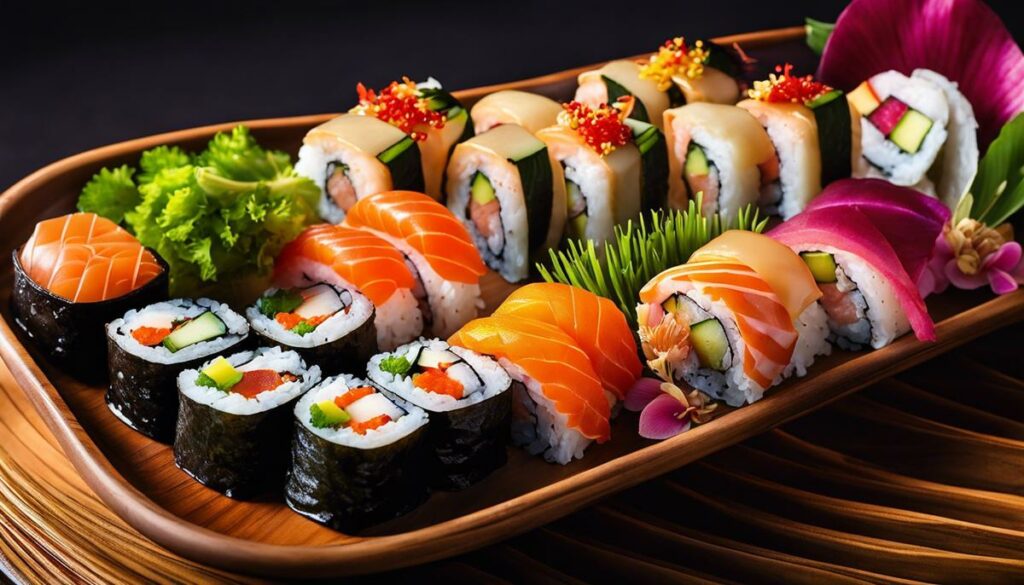Yes, food is a necessity, but it can also be an art form, a social phenomenon, and sometimes even a political statement. In this sense, our discourse on sushi and street food combines the multiple aspects of the modern lifestyle. The aesthetics of these culinary works of art not only highlight the taste, but also the craftsmanship and artistic skill behind them. The role of social media plays a crucial role in bringing this diversity to the fore, while fashion houses bring their interpretive vision to the table. Finally, it introduces the growing movement of sustainability, which shapes how we view, produce, and consume sushi and street food.
The aesthetics of sushi and street food
A graceful slice of sushi or a lively street brimming with delicious street food – these culinary experiences define not only our taste buds, but also our global lifestyle. The visual presence and authentic identity of these culinary phenomena have made them true beacons of contemporary lifestyle.
To understand how sushi and street food affect our lifestyle, it is first important to recognize their cultural background. Sushi, an aesthetically pleasing art form, symbolizes the subtle artistry and deep cultural significance of Japanese cuisine. Street food, on the other hand, reflects the vibrant life and vibrant culture of different streets around the world.
The rising popularity of sushi in the Western world is partly due to its “Instagram-worthy” charm. Prepared with perfection and precision, each piece is presented as a work of art that attracts eaters while awakening an inner aesthetic that goes far beyond culinary enjoyment. It has a clear form of expression and at the same time conveys a harmony of the senses.
Much like street food, with its rendition of authenticity, convenience and cultural diversity, it has developed a global community of foodies who, with their cameras at the ready, are ready to capture a wide variety of taste sensations. This visual delight contributes to the formation of the global lifestyle by creating an atmosphere of community and unity through the shared enjoyment of food and culture.
These two culinary phenomena add the notion of “edible design” to humanity by highlighting the previously neglected aspect of aesthetics. It’s no longer enough to just taste good; the food must also be visually appealing.
This has left a clear mark on the collective consciousness and is symbolic of the importance we attach to aesthetic expression today. It supports the idea that aesthetics have a significant impact on the global lifestyle, and it is foreseeable that it will continue to play a dominant role in shaping our lifestyles in the future.
Simply put, sushi and street food are not only promises of delicious taste, but also visual delight and cultural enjoyment that enrich and continue to shape all aspects of our lifestyle.
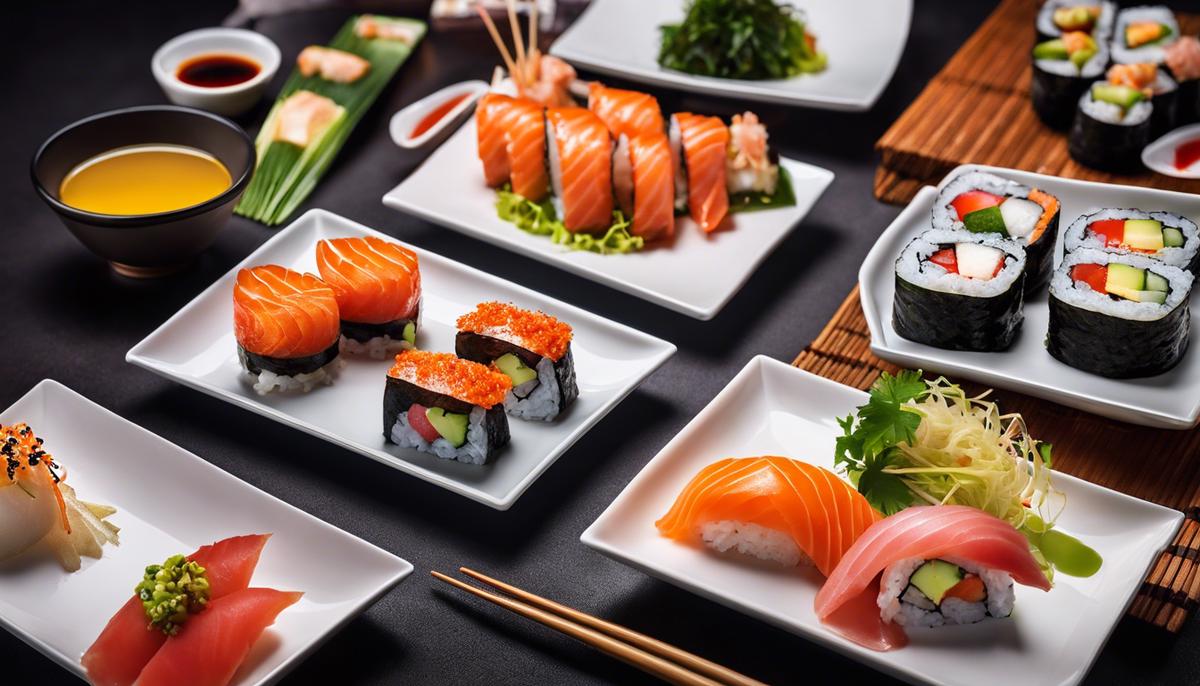
The role of social media
<
>Die Rolle von Social Media in der Förderschaft von Sushi und Street Food<
>
Die digitale Ära hat der Welt völlig neue Dimensionen eröffnet, speziell in der Lebensart und im Lebensstil. Das Phänomen sozialer Medien unterstreicht seine Fähigkeit, den Puls weltweiter Trends zu bestimmen und zu beeinflussen. Besonders bemerkenswert ist die lebendige Kombination von sozialen Medien mit der Kulinarik. Speziell Sushi und Street Food haben von dieser Symbiose profitiert und erfreuen sich einer wachsenden Beliebtheit. Sushi, die japanische Delikatesse mit einer starken ästhetischen Ausstrahlungskraft, und Street Food, die ehrliche Speisenauswahl aus der Welt der Straßenküchen, sind zu modernen Ikonen der digitalen Foodie-Kultur geworden.<
Die Schönheit von Sozialen Medien liegt in ihrer Fähigkeit, die vielfältigsten Geschmacksrichtungen und Gaumenerlebnisse zu transportieren und mit nur einem Klick teilen zu können. Foodie-Profile auf Instagram und Pinterest machen aus dem Auge essenden Sushi und aus Street Food eine betörende visuelle Erfahrung. Der Austausch von Food-Bildern auf sozialen Medien bewirkt einen Dialog zwischen Kulturen und erstellt eine globale Gemeinschaft, die das Besondere in unserem Alltag feiert.<
Sushi, mit seiner makellosen Präsentation und meisterhaften Kunstfertigkeit, visualisiert so nah wie kaum ein anderer Gaumenkitzel, die önophile Liebe zum Detail. Die minimalistische, fast zenartige Ästhetik von Sushi harmonisiert perfekt mit den Werten der Social Media Generation, die Beständigkeit und Perfektion verehrt.<
Street Food hingegen verkörpert eine unprätentiöse, rohe Genusserfahrung und reflektiert das pulsierende Leben und den kulturellen Reichtum einer Stadt oder eines Landes. Die Street Food Bewegung ist eine rebellische Antwort auf die sterile und anonyme Fast Food Kultur und bietet eine authentische und sinnliche Genusserfahrung.<
Die Art und Weise, wie soziale Medien Sushi und Street Food vermarkten, ist ein Beweis dafür, wie kraftvoll visuelle Reize und Storytelling zusammenwirken können. Jedes Foto, jedes Rezept, jede Gourmetkritik ist eine persönliche Einladung, sich dem globalen Fest der Aromen anzuschließen. Es feiert die Gaumenfreuden, unabhängig von Grenzen und Kulturen, und betont die einheitliche Sprache des Essens. Soziale Medien sind zu einem unschätzbaren Werkzeug geworden, um die Welt durch Essen und Trinken zu entdecken und einzigartige kulinarische Abenteuer zu erleben.<
Sushi und Street Food sind mehr als nur Gerichte – sie sind Ausdruck einer Lifestyle-Revolution, die von Ästhetik, Handwerkskunst und Kulturen geprägt ist. Durch soziale Medien werden sie zu Botschaftern der Genussvielfalt und der kulinarischen Neugier. Sie zeigen uns lebhaft, wie Essen eine Sprache ist, die so universell wie beeindruckend ist.<
>
<
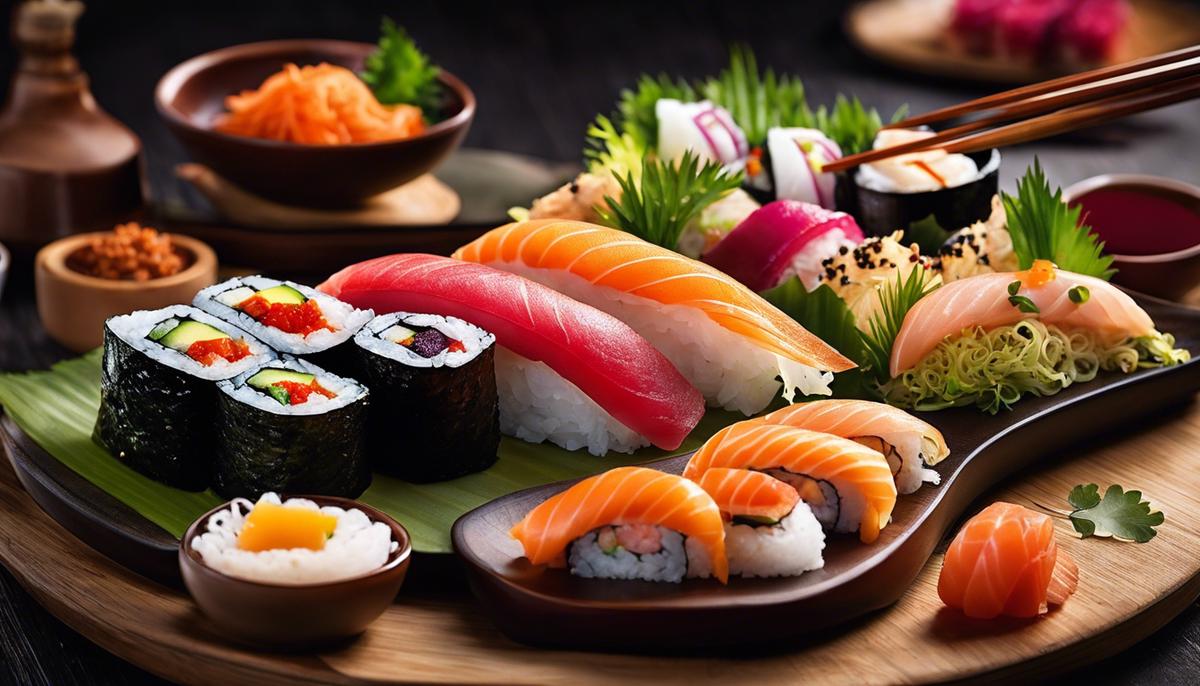
Sushi and street food in the fashion industry
The beauty of food and its depiction has long since found its way into the fiber of any social media, with the colorful maki rolls of sushi or the rustic appeal of street food now even influencing the interface design of the fashion industry. Yes, that’s right, fashion and food share the spotlight when it comes to visual aesthetics and a true sense of luxury.
The impact of digitalization on our lifestyles and the way we live cannot be overstated. As this ever-evolving technological landscape has changed, so has our definition of aesthetics. Social media has created a direct channel to showcase culinary culture and has a huge impact on how this industry presents its offerings.
The popularity of sushi and street food has steadily increased in recent years. Not only have they influenced our tastes, but also the way we curate our own aesthetics. Both sushi and street food share a unique flair for color, texture, and pattern, which is also significant in the fashion industry.
In a way, the growth of these two trendsetters is a direct result of visual storytelling. Combined with the wide range of flavors they offer, sushi and street food are not only visually appealing, but also a journey steeped in history and culture.
Social media plays an important role in this culinary revolution, as it serves as a platform to discover and experience these culinary adventures. Whether it’s a traveler seeking the ultimate street food experience in a crowded alley of Bangkok or a foodie sharing the visual delight of a perfectly cooked sushi on Instagram, everything is presented through the lens of the modern digital world.
In conclusion, the importance of aesthetics, craftsmanship and cultural influences in the field of sushi and street food is high, providing an exciting intersection with the fashion trends. The universal language of food allows us to make connections between different cultures, as we gather on this common platform to share both the aesthetics and the joy associated with food. It’s clear that sushi and street food have long since outgrown the horizon and are deeply rooted in our everyday aesthetic consciousness.
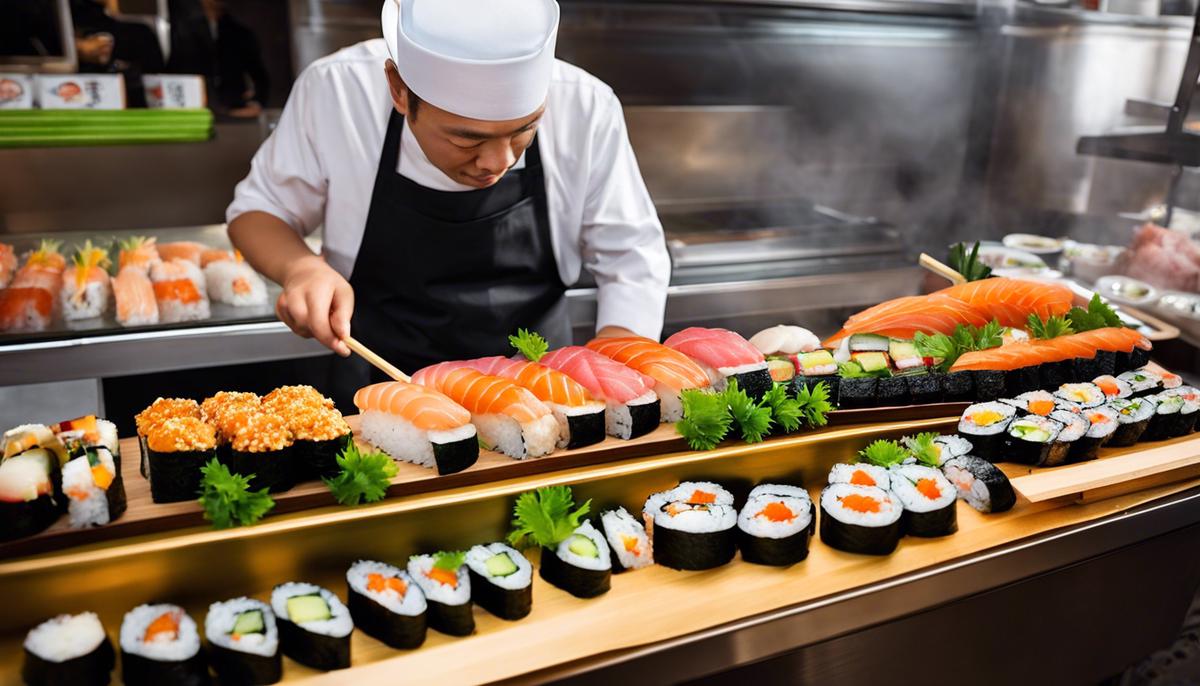
Sushi and street food
When we dive into the world of street food trends and sushi culture, we inevitably discover the aspect of sustainability. Preserving our environment and raising awareness of ecological practices has a profound impact on the food sector, especially the growing market of street food and sushi.
The topic of sustainability has a high priority in the lifestyle of modern foodies and influencers. It sheds light on the need to consume responsibly without sacrificing aesthetics and taste. The quest to incorporate sustainable practices into our eating habits has led sushi bars and street food stalls around the world to adopt more eco-friendly solutions.
Packaging made from biodegradable materials, reusable crockery sets and cutlery, and avoiding plastic are just some of the measures that reduce the environmental footprint of these thriving food cultures. This movement can be clearly seen in the visually appealing images of sustainable food packaging and plastic-free consumption on social media.
The use of local, seasonal and organic products has also gained popularity. More than ever, consumers appreciate the authenticity, freshness and quality of the ingredients. Not only does this provide a tasteful experience, but it also promotes sustainable farming and strengthens the local economy.
In the sushi world, increasing concerns about protecting the oceans and consuming seafood responsibly has led to a greater focus on sustainable fishing and vegetarian alternatives. Similar changes have been observed among street food vendors, with a greater focus on plant-based and ethically sourced ingredients.
To sum up, sustainability is an essential factor in the contemporary sushi and street food trend. It is not only a question of ecological responsibility, but also a central aspect of the aesthetic and culinary experience. By being aware of sustainable practices, we can continue to enjoy the joys of food while helping to preserve our planet for future generations.
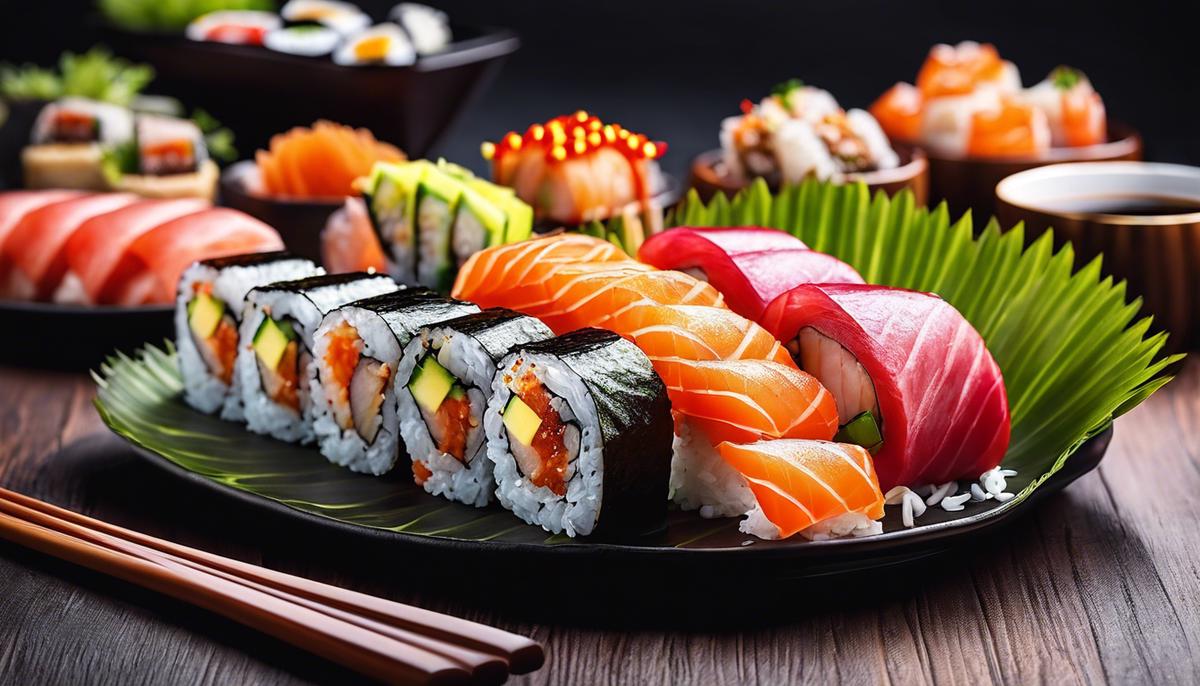
With the ever-growing appreciation for sushi and street food worldwide, our research has shown that this is more than just a culinary trend. It is a movement that is intensified by social media, inspiring the fashion industry and incorporating sustainable practices in its production. By considering aesthetics and craftsmanship, the importance of these food cultures is highlighted. Thus, in today’s society, sushi and street food are not just mere food, but also lifestyle insignia that appeal to our taste buds and at the same time set a milestone for current social and cultural trends.
